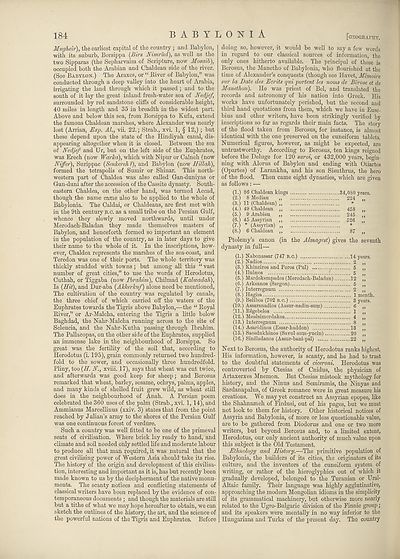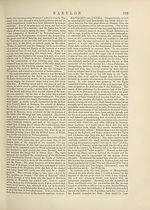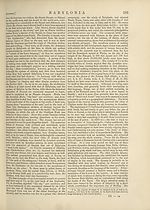Encyclopaedia Britannica > Volume 3, Athens-BOI
(196) Page 184
Download files
Complete book:
Individual page:
Thumbnail gallery: Grid view | List view

184
Mugheir), the earliest capital of the country ; and Babylon,
with its suburb, Borsippa (Sirs Nirnrud), as well as the
two Sipparas (the Sepharvaim of Scripture, now Mosaib),
occupied both the Arabian and Chaldean side of the river.
(See Babylon.) The Araxes, or “ Biver of Babylon,” was
conducted through a deep valley into the heart of Arabia,
irrigating the land through which it passed; and to the
south of it lay the great inland fresh-water sea of Nedjef,
surrounded by red sandstone cliffs of considerable height,
40 miles in length and 35 in breadth in the widest part.
Above and below this sea, from Borsippa to Kufa, extend
the famous Chaldean marshes, where Alexander was nearly
lost (Arrian, Exp. Al., vii. 22.; Strab., xvi. 1, § 12,) ; but
these depend upon the state of the Hindiyah canal, dis¬
appearing altogether when it is closed. Between the sea
of Nedjef and Ur, but on the left side of the Euphrates,
was Erech (now Warha), which with Nipur or Calneh (now
Niffer), Surippac (Senkereh?), and Babylon (now Hillah),
formed the tetrapolis of Sumir or Shinar. This north¬
western part of Chaldea was also called Gan-duniyas or
Gun-duni after the accession of the Cassite dynasty. South¬
eastern Chaldea, on the other hand, was termed Accad,
though the name came also to be applied to the whole of
Babylonia. The Caldai, or Chaldeans, are first met with
in the 9th century p.c. as a small tribe on the Persian Gulf,
whence they slowly moved northwards, until under
Merodach-Baladan they made themselves masters of
Babylon, and henceforth formed so important an element
in the population of the country, as in later days to give
their name to the whole of it. In the inscriptions, how¬
ever, Chaldea represents the marshes of the sea-coast, and
Teredon was one of their ports. The whole territory was
thickly studded with towns; but among all this “ vast
number of great cities,” to use the words of Herodotus,
Cuthah, or Tiggaba (now Ibrahim), Chilmad (Kalwadah),
Is {Hit), and Dur-aba {Akkerlcuf) alone need be mentioned,
The cultivation of the country was regulated by canals,
the three chief of which carried off the waters of the
Euphrates towards the Tigris above Babylon,—the “ Royal
River,” or Ar-Malcha, entering the Tigris a little below
Baghdad, the Nahr-Malcha running across to the site of
Seleucia, and the Nahr-Kutha passing through Ibrahim.
The Pallacopas, on the other side of the Euphrates, supplied
an immense lake in the neighbourhood of Borsippa. So
great was the fertility of the soil that, according to
Herodotus (i. 193), grain commonly returned two hundred¬
fold to the sower, and occasionally three hundredfold.
Pliny, too (//. N., xviii. 17), says that wheat was cut twice,
and afterwards was good keep for sheep; and Berosus
remarked that wheat, barley, sesame, ochrys, palms, apples,
and many kinds of shelled fruit grew wild, as wheat still
does in the neighbourhood of Anah. A Persian poem
celebrated the 360 uses of the palm (Strab., xvi. 1, 14), and
Ammianus Marcellinus (xxiv. 3) states that from the point
reached by Julian’s army to the shores of the Persian Gulf
was one continuous forest of verdure.
Such a country was well fitted to be one of the primeval
seats of civilisation. Where brick lay ready to hand, and
climate and soil needed only settled life and moderate labour
to produce all that man required, it was natural that the
great civilising power of Western Asia should take its rise.
The history of the origin and development of this civilisa¬
tion, interesting and important as it is, has but recently been
made known to us by the decipherment of the native monu¬
ments. The scanty notices and conflicting statements of
classical writers have been replaced by the evidence of con¬
temporaneous documents; and though the materials are still
but a tithe of what we may hope hereafter to obtain, we can
sketch the outlines of the history, the art, and the science of
the powerful nations of the Tigris and Euphrates. Before
[GEOGKArilY.
doing so, however, it would be well to say a few words
in regard to our classical sources of information, the
only ones hitherto available. The principal of these is
Berosus, the Manetho of Babylonia, who flourished at the
time of Alexander’s conquests (though see Havet, Memoire
sur la Date des Ecrits qui portent les noms de Berose et dc
Manethon). He was priest of Bel, and translated the
records and astronomy of his nation into Greek. His
works have unfortunately perished, but the second and
third hand quotations from them, which we have in Euse¬
bius and other writers, have been strikingly verified by
inscriptions so far as regards their main facts. The story
of the flood taken from Berosus, for instance, is almost
identical with the one preserved on the cuneiform tablets.
Numerical figures, however, as might be expected, are
untrustworthy. According to Berosus, ten kings reigned
before the Deluge for 120 saroi, or 432,000 years, begin¬
ning with Alorus of Babylon and ending with Otiartes
(Opartes) of Larankha, and his son Sisuthrus, the hero
of the flood. Then came eight dynasties, which are given
as follows : —
(1.) 86 Chaldean kings 84,080 years.
(2.) 8 Median ,, 224
(3.) 11 (Chaldean) ,, *
(4.) 49 Chaldean ,, 458 ,,
(5.) 9 Arabian 245 ,,
(6.) 45 Assyrian ,, 526 ,,
(7.) * (Assyrian) *
(8.) 6 Chaldean ,, 87 ,,
Ptolemy’s canon (in the Almagest) gives the seventh
dynasty in full—
(1.) Nabonassar (747 b.c.) 14 years.
(2.) Radios 2 ,,
(3.) Khinziros and Poros (Pul) 5 ,,
(4.) Ilulseos (. 5 ,,
(5.) Mardokempados (Merodach-Baladan) 12 ,,
(6.) Arkeanos (Sargon). 5 ,,
(7.) Interregnum 2 ,,
8. ) Hagisa 1 month.
9. ) Belibos (702 b.c.) 3 years.
(10.) Assaranadios (Assur-nadin-sum) 6 ,,
(11.) Regebelos 1 ,,
(l2.) Mesesimordakos 4 ,,
(13.) Interregnum 8 ,,
(14.) Asaridinos (Essar-haddon) 13 ,,
(15.) Saosdukhinos (Savul-sum-yucin) 20 ,,
(16.) Sineladanos (Assur-bani-pal) 22 ,,
Next to Berosus, the authority of Herodotus ranks highest.
His information, however, is scanty, and he had to trust
to the doubtful statements of ciceroni. Herodotus was
controverted by Ctesias of Cnidus, the physician of
Artaxerxes Mnemon. But Ctesias mistook mythology for
history, and the Ninus and Semiramis, the Ninyas and
Sardanapalus, of Greek romance were in great measure his
creations. We may yet construct an Assyrian epopee, like
the Shahnameh of Eirdusi, out of his pages, but we must
not look to them for history. Other historical notices of
Assyria and Babylonia, of more or less questionable value,
are to be gathered from Diodorus and one or two more
writers, but beyond Berosus and, to a limited extent,
Herodotus, our only ancient authority of much value upon
this subject is the Old Testament.
Ethnology and History.—The primitive population of
Babylonia, the builders of its cities, the originators of its
culture, and the inventors of the cuneiform system of
writing, or rather of the hieroglyphics out of which it
gradually developed, belonged to the Turanian or Ural-
Altaic family. Their language was highly agglutinative,
approaching the modern Mongolian idioms in the simplicity
of its grammatical machinery, but otherwise more nearly
related to the Ugro-Bulgaric division of the Finnic group;
and its speakers were mentally in no way inferior to the
Hungarians and Turks of the present day. The country
BABYLONIA
Mugheir), the earliest capital of the country ; and Babylon,
with its suburb, Borsippa (Sirs Nirnrud), as well as the
two Sipparas (the Sepharvaim of Scripture, now Mosaib),
occupied both the Arabian and Chaldean side of the river.
(See Babylon.) The Araxes, or “ Biver of Babylon,” was
conducted through a deep valley into the heart of Arabia,
irrigating the land through which it passed; and to the
south of it lay the great inland fresh-water sea of Nedjef,
surrounded by red sandstone cliffs of considerable height,
40 miles in length and 35 in breadth in the widest part.
Above and below this sea, from Borsippa to Kufa, extend
the famous Chaldean marshes, where Alexander was nearly
lost (Arrian, Exp. Al., vii. 22.; Strab., xvi. 1, § 12,) ; but
these depend upon the state of the Hindiyah canal, dis¬
appearing altogether when it is closed. Between the sea
of Nedjef and Ur, but on the left side of the Euphrates,
was Erech (now Warha), which with Nipur or Calneh (now
Niffer), Surippac (Senkereh?), and Babylon (now Hillah),
formed the tetrapolis of Sumir or Shinar. This north¬
western part of Chaldea was also called Gan-duniyas or
Gun-duni after the accession of the Cassite dynasty. South¬
eastern Chaldea, on the other hand, was termed Accad,
though the name came also to be applied to the whole of
Babylonia. The Caldai, or Chaldeans, are first met with
in the 9th century p.c. as a small tribe on the Persian Gulf,
whence they slowly moved northwards, until under
Merodach-Baladan they made themselves masters of
Babylon, and henceforth formed so important an element
in the population of the country, as in later days to give
their name to the whole of it. In the inscriptions, how¬
ever, Chaldea represents the marshes of the sea-coast, and
Teredon was one of their ports. The whole territory was
thickly studded with towns; but among all this “ vast
number of great cities,” to use the words of Herodotus,
Cuthah, or Tiggaba (now Ibrahim), Chilmad (Kalwadah),
Is {Hit), and Dur-aba {Akkerlcuf) alone need be mentioned,
The cultivation of the country was regulated by canals,
the three chief of which carried off the waters of the
Euphrates towards the Tigris above Babylon,—the “ Royal
River,” or Ar-Malcha, entering the Tigris a little below
Baghdad, the Nahr-Malcha running across to the site of
Seleucia, and the Nahr-Kutha passing through Ibrahim.
The Pallacopas, on the other side of the Euphrates, supplied
an immense lake in the neighbourhood of Borsippa. So
great was the fertility of the soil that, according to
Herodotus (i. 193), grain commonly returned two hundred¬
fold to the sower, and occasionally three hundredfold.
Pliny, too (//. N., xviii. 17), says that wheat was cut twice,
and afterwards was good keep for sheep; and Berosus
remarked that wheat, barley, sesame, ochrys, palms, apples,
and many kinds of shelled fruit grew wild, as wheat still
does in the neighbourhood of Anah. A Persian poem
celebrated the 360 uses of the palm (Strab., xvi. 1, 14), and
Ammianus Marcellinus (xxiv. 3) states that from the point
reached by Julian’s army to the shores of the Persian Gulf
was one continuous forest of verdure.
Such a country was well fitted to be one of the primeval
seats of civilisation. Where brick lay ready to hand, and
climate and soil needed only settled life and moderate labour
to produce all that man required, it was natural that the
great civilising power of Western Asia should take its rise.
The history of the origin and development of this civilisa¬
tion, interesting and important as it is, has but recently been
made known to us by the decipherment of the native monu¬
ments. The scanty notices and conflicting statements of
classical writers have been replaced by the evidence of con¬
temporaneous documents; and though the materials are still
but a tithe of what we may hope hereafter to obtain, we can
sketch the outlines of the history, the art, and the science of
the powerful nations of the Tigris and Euphrates. Before
[GEOGKArilY.
doing so, however, it would be well to say a few words
in regard to our classical sources of information, the
only ones hitherto available. The principal of these is
Berosus, the Manetho of Babylonia, who flourished at the
time of Alexander’s conquests (though see Havet, Memoire
sur la Date des Ecrits qui portent les noms de Berose et dc
Manethon). He was priest of Bel, and translated the
records and astronomy of his nation into Greek. His
works have unfortunately perished, but the second and
third hand quotations from them, which we have in Euse¬
bius and other writers, have been strikingly verified by
inscriptions so far as regards their main facts. The story
of the flood taken from Berosus, for instance, is almost
identical with the one preserved on the cuneiform tablets.
Numerical figures, however, as might be expected, are
untrustworthy. According to Berosus, ten kings reigned
before the Deluge for 120 saroi, or 432,000 years, begin¬
ning with Alorus of Babylon and ending with Otiartes
(Opartes) of Larankha, and his son Sisuthrus, the hero
of the flood. Then came eight dynasties, which are given
as follows : —
(1.) 86 Chaldean kings 84,080 years.
(2.) 8 Median ,, 224
(3.) 11 (Chaldean) ,, *
(4.) 49 Chaldean ,, 458 ,,
(5.) 9 Arabian 245 ,,
(6.) 45 Assyrian ,, 526 ,,
(7.) * (Assyrian) *
(8.) 6 Chaldean ,, 87 ,,
Ptolemy’s canon (in the Almagest) gives the seventh
dynasty in full—
(1.) Nabonassar (747 b.c.) 14 years.
(2.) Radios 2 ,,
(3.) Khinziros and Poros (Pul) 5 ,,
(4.) Ilulseos (. 5 ,,
(5.) Mardokempados (Merodach-Baladan) 12 ,,
(6.) Arkeanos (Sargon). 5 ,,
(7.) Interregnum 2 ,,
8. ) Hagisa 1 month.
9. ) Belibos (702 b.c.) 3 years.
(10.) Assaranadios (Assur-nadin-sum) 6 ,,
(11.) Regebelos 1 ,,
(l2.) Mesesimordakos 4 ,,
(13.) Interregnum 8 ,,
(14.) Asaridinos (Essar-haddon) 13 ,,
(15.) Saosdukhinos (Savul-sum-yucin) 20 ,,
(16.) Sineladanos (Assur-bani-pal) 22 ,,
Next to Berosus, the authority of Herodotus ranks highest.
His information, however, is scanty, and he had to trust
to the doubtful statements of ciceroni. Herodotus was
controverted by Ctesias of Cnidus, the physician of
Artaxerxes Mnemon. But Ctesias mistook mythology for
history, and the Ninus and Semiramis, the Ninyas and
Sardanapalus, of Greek romance were in great measure his
creations. We may yet construct an Assyrian epopee, like
the Shahnameh of Eirdusi, out of his pages, but we must
not look to them for history. Other historical notices of
Assyria and Babylonia, of more or less questionable value,
are to be gathered from Diodorus and one or two more
writers, but beyond Berosus and, to a limited extent,
Herodotus, our only ancient authority of much value upon
this subject is the Old Testament.
Ethnology and History.—The primitive population of
Babylonia, the builders of its cities, the originators of its
culture, and the inventors of the cuneiform system of
writing, or rather of the hieroglyphics out of which it
gradually developed, belonged to the Turanian or Ural-
Altaic family. Their language was highly agglutinative,
approaching the modern Mongolian idioms in the simplicity
of its grammatical machinery, but otherwise more nearly
related to the Ugro-Bulgaric division of the Finnic group;
and its speakers were mentally in no way inferior to the
Hungarians and Turks of the present day. The country
BABYLONIA
Set display mode to:
![]() Universal Viewer |
Universal Viewer | ![]() Mirador |
Large image | Transcription
Mirador |
Large image | Transcription
Images and transcriptions on this page, including medium image downloads, may be used under the Creative Commons Attribution 4.0 International Licence unless otherwise stated. ![]()
| Encyclopaedia Britannica > Encyclopaedia Britannica > Volume 3, Athens-BOI > (196) Page 184 |
|---|
| Permanent URL | https://digital.nls.uk/193652849 |
|---|
| Attribution and copyright: |
|
|---|---|
| Shelfmark | EB.17 |
|---|---|
| Description | Ten editions of 'Encyclopaedia Britannica', issued from 1768-1903, in 231 volumes. Originally issued in 100 weekly parts (3 volumes) between 1768 and 1771 by publishers: Colin Macfarquhar and Andrew Bell (Edinburgh); editor: William Smellie: engraver: Andrew Bell. Expanded editions in the 19th century featured more volumes and contributions from leading experts in their fields. Managed and published in Edinburgh up to the 9th edition (25 volumes, from 1875-1889); the 10th edition (1902-1903) re-issued the 9th edition, with 11 supplementary volumes. |
|---|---|
| Additional NLS resources: |
|

